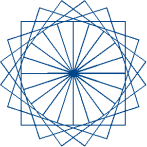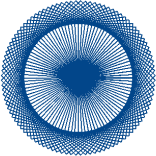Or search by topic
Number and algebra
Geometry and measure
Probability and statistics
Working mathematically
Advanced mathematics
For younger learners
First Forward Into Logo 3: Repeat REPEAT



- Problem
First Forward Into Logo
Previous: FF2
Now that you have seen how easy it is to draw squares triangles, pentagons, hexagon, heptagons etc. let us use these shapes as basic units of a pattern.
Why not repeat what you have already repeated!
Imagine:
Drawing a square (Say, REPEAT 4 [FD 50 RT 90])
Now turn 30 ° left.
Draw another square.
Now turn another 30 °.
Draw another square.
Now turn another 30 °.
Draw another square.
Now turn another 30 ° and so on until you get back to where you started.
Now this is really: REPEAT 12 [REPEAT 4 [ FD 50 RT 90] LT 30] (hint: 12 x 30 is 360)
 |
 |
 |
Why not experiment with other turns, other sizes, other shapes.....other...?
You might also want to experiment with changing the colour of your pen:
PENCOLOUR (abbreviation PC). You need to tell this primitive how much
[Red Green Blue] to mix to make your pencolour.
Try [255 0 0] - and start drawing. Was it what you expected?
N.B. 255 is the largest amount of any colour you can use.
SHOW PC tells you what pencolour you are using.
Next: FF4
Related Collections
You may also like
First Forward Into Logo 1: Square Five
A Short introduction to using Logo. This is the first in a twelve part series.
LOGO Challenge 1 - Star Square
Can you use LOGO to create this star pattern made from squares. Only basic LOGO knowledge needed.
LOGO Challenge 5 - Patch
Using LOGO, can you construct elegant procedures that will draw this family of 'floor coverings'?

